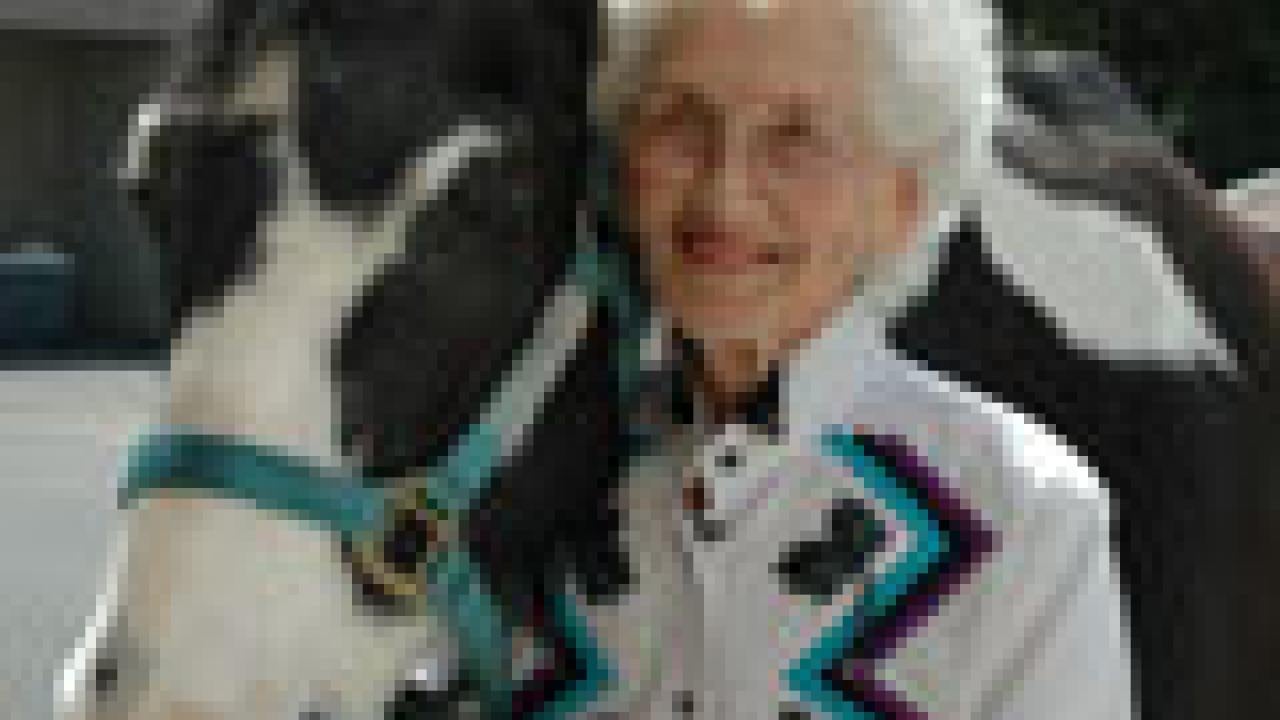The Winters parade came and went, with no Dino, the black-and-white paint horse known to parade goers far and wide. The Dixon May Fair Parade came and went last weekend, with no Dino. And no Peggy Narducci in the saddle.
The parade veterans had taken some time off while Dino underwent intestinal surgery at the UC Davis Veterinary Medical Teaching Hospital. He suffered from colic, the leading cause of death in adult horses.
The surgery went well and Dino's prognosis seemed good, thanks to UC Davis research, but he came down with pneumonia. "He was in misery," Narducci said. Monday, after consulting with her, the hospital staff put Dino down.
"He was a beautiful animal," Narducci said. "I don't think I would have lived this long if it hadn't been for Dino."
Narducci turned 90 the day Dino died.
Dino was 30 years old — elderly in horse years — and some owners might have decided against the surgery, considering the trauma on the horse, not to mention the expense.
But this was no ordinary horse. Dino was as gentle as could be, very sweet, and he loved children, Narducci said. "He was a big ham," she said. "He loved to perform."
In other words, Dino was perfect for parades — and people anticipated seeing him and Narducci year after year. They had appeared in more than 550 parades, including the Tournament of Roses procession 13 times.
Narducci is not so ordinary herself. Take, for example, the fact that she did not start riding until she was 64.
She did not hesitate about the surgery, performed on April 24. A team of veterinarians and students removed about 10 feet of Dino's small intestine. What did that leave him with? Actually, quite a lot, since a horse's small intestine is 60 to 70 feet long, said Jack Snyder, one of three vets on the surgery team. Joining him were Sarah Le Jeune and Omar Maher.
Jorge Nieto, another UC Davis equine veterinarian, explained that a benign tumor had developed at the top of Dino's abdominal cavity, and part of the small intestine became knotted around the tumor — resulting in colic.
Nieto said the knotted portion of intestine lost its blood supply and essentially died — releasing toxins into Dino's abdomen and bloodstream. Nieto said the surgical team spent a half-hour or longer freeing the knot. Then the team cut out the bad intestine and tied the two good ends together.
Four days after the surgery, Dino's keepers reintroduced him to regular feed, a little at a time.
"We are going really slow because we know he's an old guy," Nieto said outside Dino's stall in the equine intensive care unit on May 5.
One of the lessons to be learned from Dino's case is that "when we treat older animals, we need to be more patient," Nieto said. "All the animals teach us something."
Narducci and her husband, Harry, moved to Yolo County nearly 22 years ago when they bought Dino. "That's why we came here," to a place northwest of Davis, to provide space for the horse.
Without the surgery, Dino would have died, Snyder said. Going into surgery, the survival prognosis in general is 30 percent to 40 percent. The odds are higher than, say, 10 years ago, thanks to UC Davis' Comparative Gastroenterology Laboratory. Snyder, the lab's director, credited faculty, postgraduate researchers and graduate students with making "major differences" in the survival rate of horses with colic.
One example of the lab's work is GI Boost, which Snyder described as "a solution made up of a group of drugs basically to improve the survival of damaged intestine, thus improving the prognosis, like in Dino's case. It took the group in the lab probably 10 years to develop."
When surgery goes well, as in Dino's case, the survival rate goes up to about 70 percent, Snyder said, though for a horse of Dino's age the odds are not that high.
Still, before Dino took a turn for the worse, Snyder and Nieto expressed optimism that the horse would be back on the parade route in 90 days. Narducci was making plans for West Sacramento's Community Day Parade on Oct. 7 and, maybe, another Rose parade.
Now, with Dino's death, Narducci said she doubts that she will return to the parade circuit. "This would have been our 22nd year together, and my 25th year in parades, and I was thinking about retiring anyway."
Her memories will live on, memories of Dino and what she and her horse meant to thousands of parade goers over the years.
"My biggest joy is the look on the people's faces when we go down the parade route ... all the happiness out there."
Media Resources
Clifton B. Parker, Dateline, (530) 752-1932, cparker@ucdavis.edu
